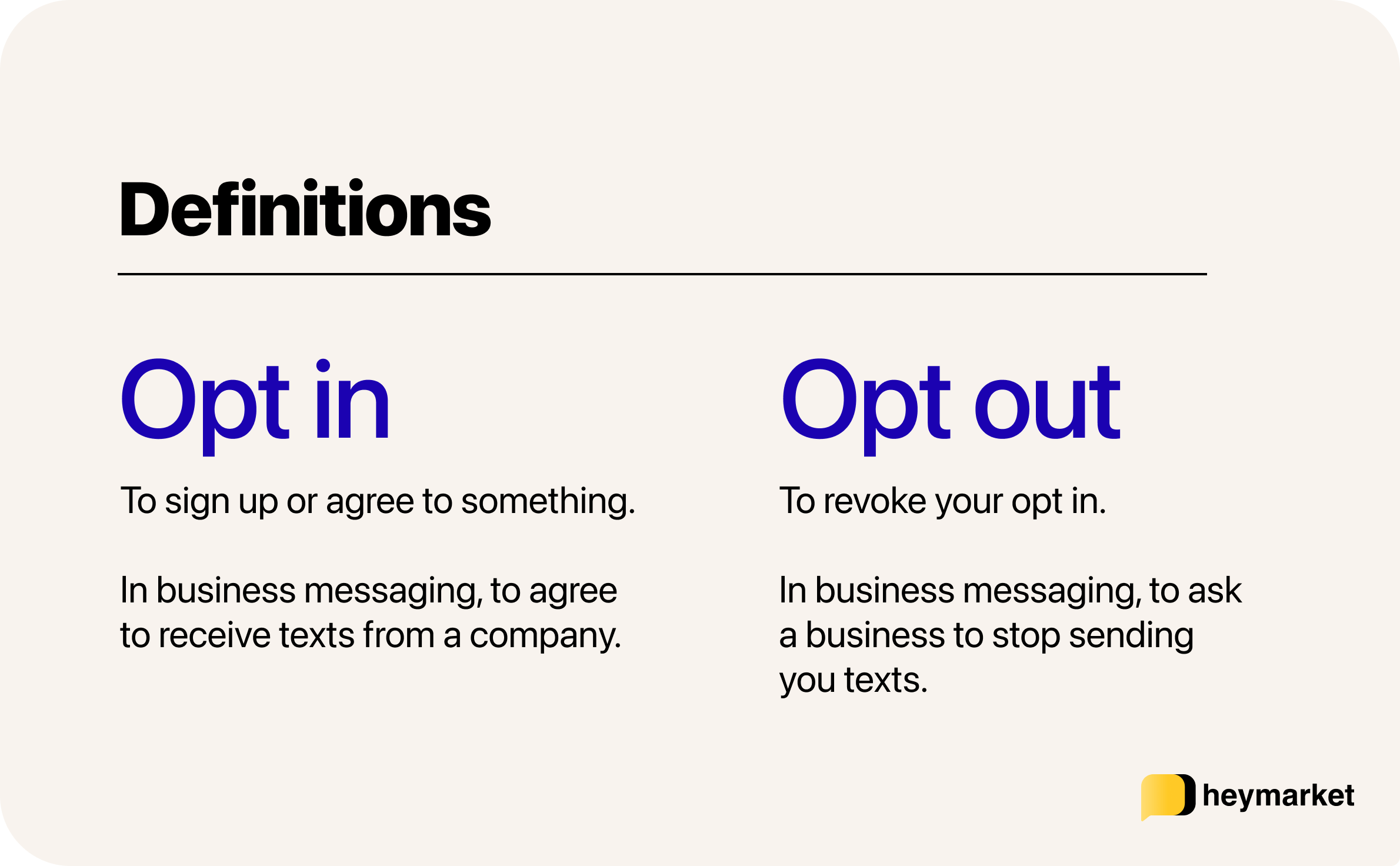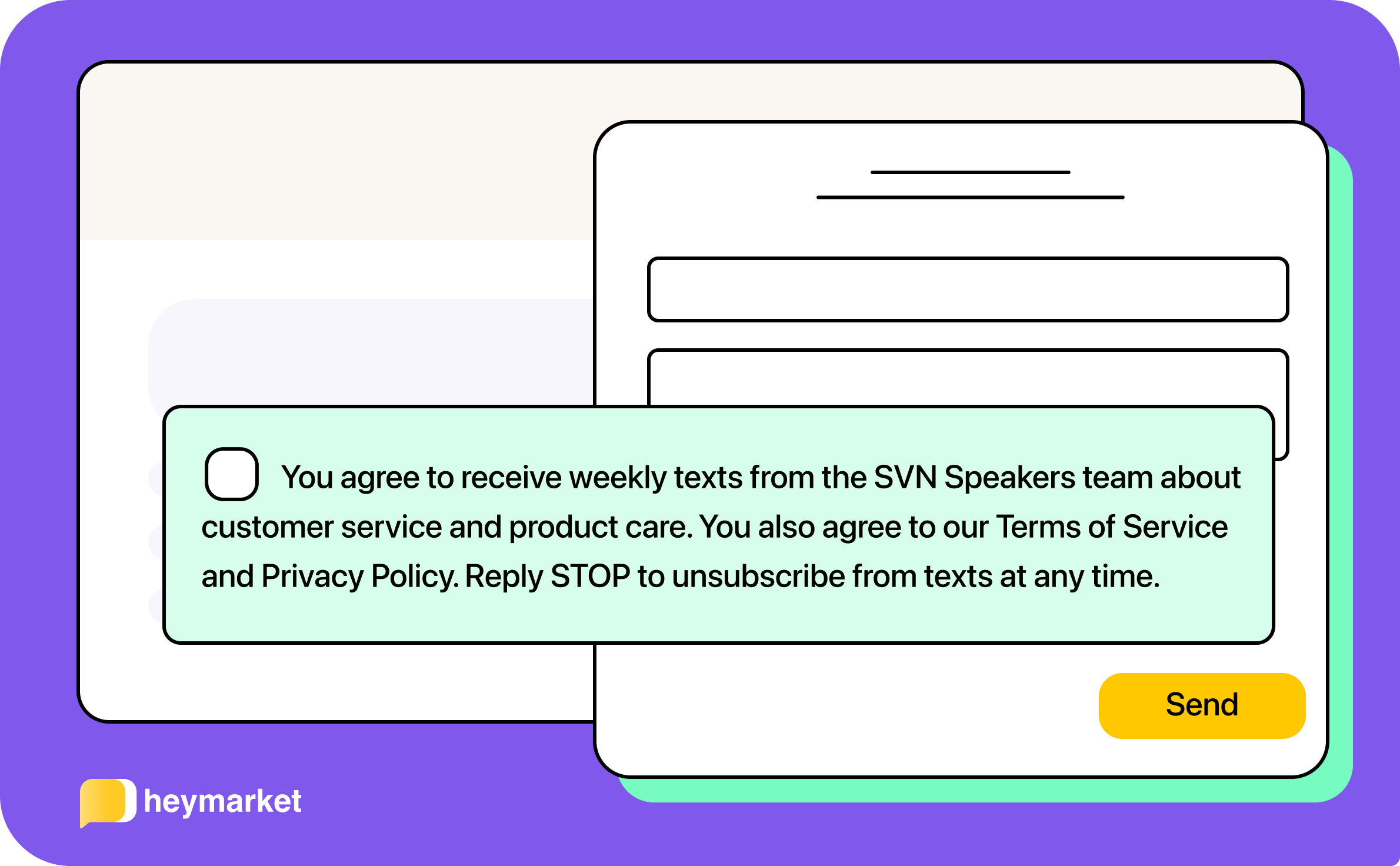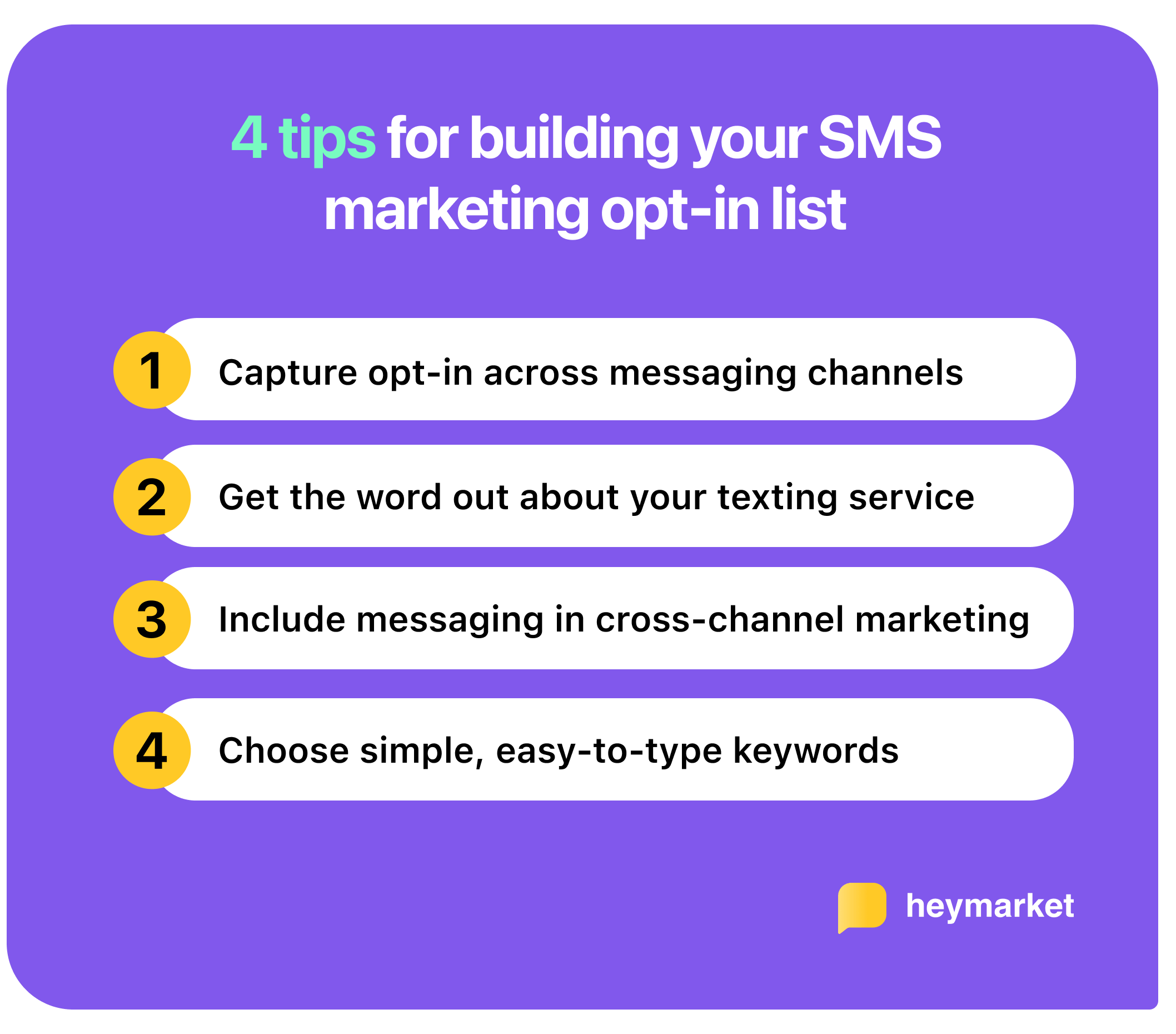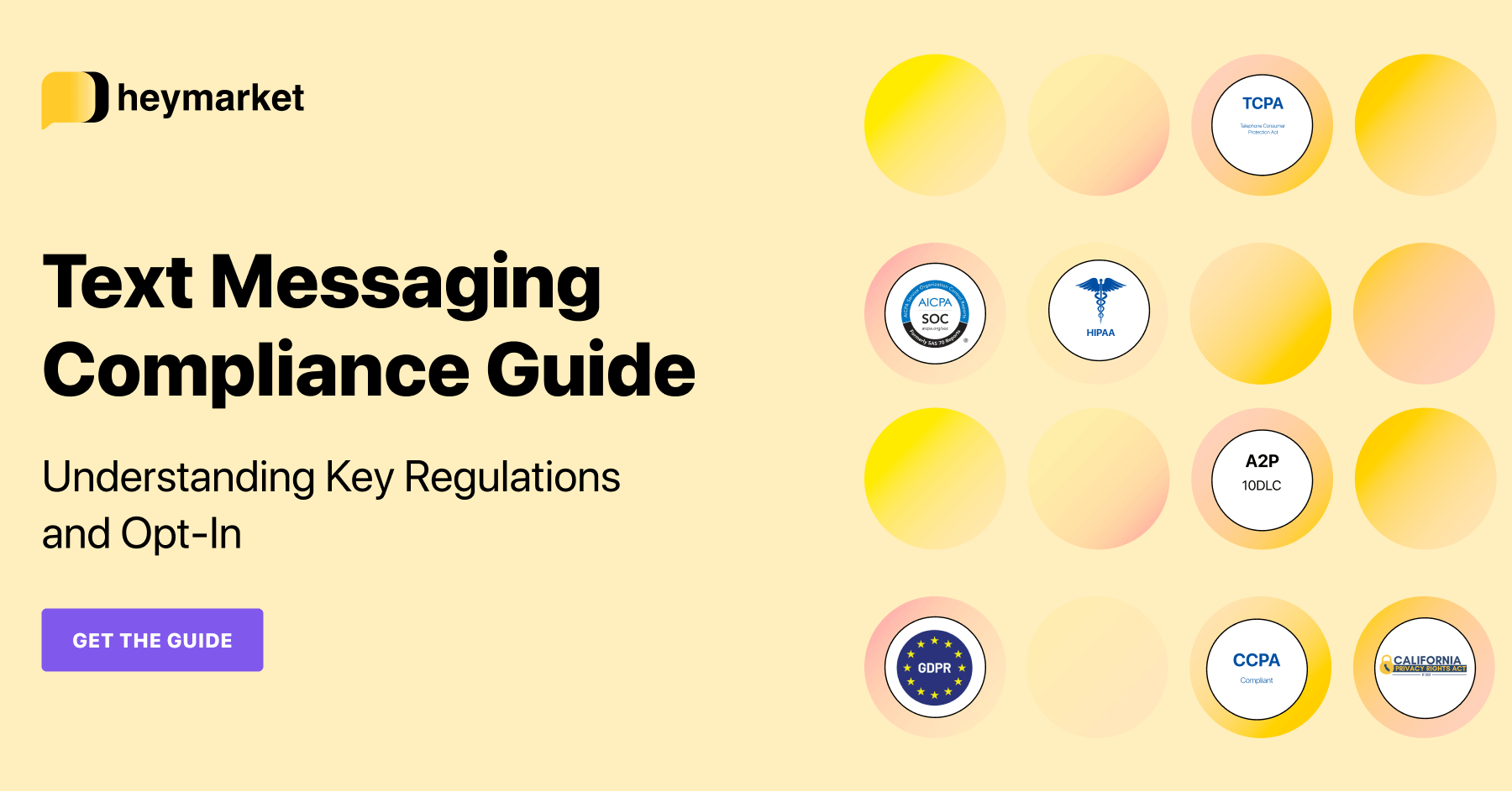Compliance with legal frameworks, such as the TCPA, may be fact- and context-specific. The information contained on this resource page should not be relied upon as legal advice or to determine how the TCPA or other laws or standards apply to your use of SMS and our service. This SMS compliance information is provided “as is” and may be updated or changed without notice. You may use this guide for your internal reference purposes only.
Messaging has grown in popularity over recent years, becoming so convenient that many people have begun messaging businesses for their customer service needs. In fact, if you’re like the average person, you probably like to communicate with your favorite businesses and organizations via SMS.
As you text with businesses, there’s a good chance you’ve seen new terminology, like opt in or opt out. But what does opt mean in texting? And should you do it? As a business, how should you handle opt ins or opt outs?
Read on to learn all about the meaning of opt in and opt out in texts.

Want a more detailed look at opt-in and SMS compliance? Read our guide.
Get the guideWhat Does Opt, Opt In, or Opt Out Mean?
If someone asks you to opt in to something, they’re asking you to sign up for it. In the texting world, if a business asks you to opt in, they’re asking you to sign up for their SMS services. In other words, they’re asking for permission to text you.
Alternatively, if someone asks whether you want to opt out of something, they’re asking if you’d like to stop doing it. If a business asks you whether you’d like to opt out, they’re asking you whether you’d like to stop receiving text messages from them.

Why Do Businesses Ask You for Permission to Text You?
Why do companies have to get your consent before sending you text messages?
First of all, they have to. The Federal Communications Commission has strict rules when it comes to businesses contacting consumers.
In fact, it’s illegal for them to reach out if you haven’t explicitly said they can in writing. The Telephone Consumer Protection Act (TCPA) says that businesses must get your consent in writing before they communicate with you via text message. It also says that businesses have to immediately stop contacting you if you opt out by texting them an opt-out keyword. (When it was passed in 1991, the TCPA was originally meant to protect you from telemarketing calls. But whenever a new customer communication channel is created—like SMS—the FCC updates the regulation.)
There’s one more reason businesses ask for permission to text you. Ensuring that you actually want to receive texts from them lets you know they care about your preferences, and helps them build a strong, trust-based relationship with you.
How Do Businesses Ask You to Opt In?
Businesses ask customers to opt into their texting service in a variety of ways. The main ones include:
- When they collect your contact information. This may happen when filling out a form or starting a web chat on their website, and the business requests your phone number. You’ll often see a box on the form that you can check to opt in.
- When you text a business. Sometimes, businesses will post their text-enabled phone number on their Contact Us page, their social media website, or their emails.They might include an opt-in keyword to text them with to confirm your opt in.
These are the most common times that you’ll see an opt-in request from a business.
Double Opt-Ins
Businesses may send a text confirming that you’ve opted in after you click a box on a web form or text in an opt-in keyword. This is called a double opt-in, and businesses use it to verify with a higher level of certainty that they’re only texting customers who want to be texted. Again, this helps them ensure they’re complying with the TCPA and building customer trust.
Some text messaging solutions offer a double opt-in tool, making it easy to verify your customers’ consent to receiveing texts. These tools may require your contact to respond with a specific confirmation keyword (e.g., “YES”) to be fully opted into messaging, and to help with compliance, not allow your team to message the contact until this process is complete.

Click to Copy to Clipboard
Copied to clipboard.
Paste anywhere you want.
What Do Opt-In Requests Look Like?
Opt-in requests typically have a formula that begins with texting in a keyword, which is often capital letters. It will most likely be something like YES or TEXTNOW, or a brand-specific term. You’ll notice that each opt-in request features corresponding opt-out information. Opt-in requests, including opt-out language, might look like the following examples.
On a Website, Social Media, or Email
Businesses sometimes post their opt-in information on their Contact Us page, social media, or emails. One of these requests may look like this:

Click to Copy to Clipboard
Copied to clipboard.
Paste anywhere you want.

Click to Copy to Clipboard
Copied to clipboard.
Paste anywhere you want.
On a Web Form
You may also encounter an opt-in checkbox on a web form after you fill out order or account information. That language may look like this:

In a Text
If you text a business first without having opted in earlier, they may ask you to confirm that you’re opting in. (This is the double opt in from earlier in the article.) A double opt in may look like this:

Click to Copy to Clipboard
Copied to clipboard.
Paste anywhere you want.

Click to Copy to Clipboard
Copied to clipboard.
Paste anywhere you want.
Why Would You Want to Opt In?
When you opt in to a business’s SMS service, you’re giving them your personal phone number in many cases. They can reach you directly, right on your phone. So why would you want to opt in to receive texts from a business?
A business’s SMS service often aims to:
- Provide you with faster customer service
- Send reminders for appointments
- Keep you up to date on orders and deliveries
- Help you get the most out of your purchases with product tips
- Provide the best customer experience possible
In other words, when you opt in to a business’s SMS service, you’re allowing a business to deliver their customer service in a format that’s convenient for you as a customer. And you reap the benefits of easily accessible customer service at the tip of your fingers.
Why Would You Want to Opt Out?
The TCPA makes sure you can opt out of texting whenever you want. As you saw from the opt-in request examples, all businesses should provide opt-out information clearly on initial texts to you and on their website. Most recognize one or all of these opt-out keywords: STOP, STOPALL, UNSUBSCRIBE, CANCEL, END, and QUIT. As soon as you text any of these keywords in, they should automatically stop texting you.
So why would you want to opt out of a business’s SMS service? You may find that:
- A company is texting you too frequently
- A business’s texts are no longer relevant to your needs
- You no longer are interested in a business
- You opted into texting by mistake
These are all reasons you may want to opt out of texting—and the business that is texting you should comply immediately. (If not, there are ways to stop spam or unwanted texts.)
Managing Opt Ins and Opt Outs as a Business
As a business, you should take customers’ subscription preferences very seriously. With the TCPA’s requirements and customers’ trust on the line, you should consider compliance with opt ins and opt outs with the utmost seriousness.
To help you manage opt ins, here are three types of opt-in situations, how to secure opt ins for promotional and informational messages, best practices, and how to grow your SMS lead list.
The 3 Types of Opt Ins
For businesses, there are different levels of opt-in required, and they depend on the purpose of the message you’re sending. Here’s a breakdown of the three main categories and the level of opt in needed, adapted from the CTIA, a trade association for the U.S wireless communications industry.
- Promotional messages. These are any messages you’d consider SMS marketing. They encourage a customer to buy something, go somewhere, or take action. These may include product tips, event notifications, or seasonal promotions. Customers must provide written permission for marketing messages specifically before you send one.
- Informational messages. These are any updates about information related to a customer’s account or relationship with your business. They may include account alerts, loyalty reminders, appointment reminders, or welcome texts. Customers must provide written or verbal permission before you start sending them these messages.
- Conversational messages. These are one-to-one messages between your team and a customer—specifically when the customer reaches out first. You don’t need to ask for written or verbal consent for these conversations. By texting you first, customers imply that you may respond to them about that topic. (But note that you can’t reach out about other topics, or for example, add them to your marketing list.)
Securing Opt In for Promotional and Informational Messages
Promotional and informational messages require written opt ins (though for informational messages, you can also ask for verbal confirmation). Here are the three steps to secure opt in for those messages:
- Choose how you want customers to opt in. They may text a code to your phone number, fill out a web form, or check a box online.
- Build an easy opt-in process. You have a few options for doing this. You can create a form that clearly describes the SMS service customers are opting into, and allow them to check a box. Another popular approach is designating an opt-in keyword, like SUBSCRIBE, which customers can text in. You can then build an automation to trigger any time a customer texts the keyword with a message confirming their opt-in.
- Confirm when customers message in. Double opt ins ensure you’re messaging consumers who want to be contacted. Send a confirmation message when they message in with that initial keyword.
Opt In and Opt Out Best Practices
Now that you have the hang of how to secure opt ins, here are some best practices:
- Always ask new messaging customers to opt in. Even if a customer has been on your email list for years, you must get their consent to message them.
- Only send information about the specific campaign customers opt in to. If they signed up for account updates, don’t send them marketing messages.
- Keep a log of customer opt-ins. Your business messaging platform can add newly opted in customers to a special list. You can also keep an opt-in log within a CRM like HubSpot. Simply use a HubSpot list segmented on custom properties for SMS opt in.
- Delete numbers that haven’t engaged in your SMS services for a while. These numbers may have been reassigned.
- Use a business messaging platform that automatically removes customers who opt out. Consider a business messaging platform that immediately removes customers who message in with your opt-out keyword.
- Include opt-out information on each initial text you send customers. Remind customers of your opt-out keywords in the first message of every conversation.
4 Tips for Growing Your SMS Lead List Using Opt Ins
Building your SMS subscriber list can be challenging at first. Here are four tips for encouraging customers to opt in:

- Capture opt in across channels. Embed a chat-to-text widget on the bottom of your page. When customers use it, ask for their phone numbers and allow them to check a box to opt in to receive texts.
- Get the word out. Include your phone number on multiple webpages. Create a special banner that draws attention to it. Post it to your social media accounts and review accounts (e.g., Yelp and Google). Add it to email communications too.
- Do some cross-channel marketing. Maximize your current marketing campaigns. Add an SMS opt-in option to a Facebook Lead Ad, include a texting option on Google ads, and add your SMS number (complete with opt-in keyword) to display ads.
- Choose simple keywords. Make it easy for customers to opt in with keywords like START or TEXT. Opt out keywords might be STOP or ENDALL.
Opting In to a Good Business-Customer Relationship
Ultimately, opt ins and opt outs are good things for both consumers and businesses.
Asking for new customers to opt in and allowing them to opt out easily helps businesses achieve SMS compliance, staying on the right side of the law—and customers’ trust. In turn, consumers get a spam-free experience, faster customer service, and a direct connection to their favorite brands.
To learn more about complying with key business SMS regulations, read our Text Messaging Compliance Guide:






